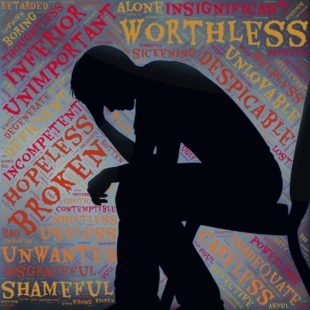Stages of Grief After Losing a Loved One to Suicide
Christian Counselor Spokane
(Note: These are stories of those struggling to come to terms with the suicide of a loved one and dealing with stages of grief as a result. For related information, see my article What is Depression? Not Just a State of Mind.)
 Shannon couldn’t tell her story without crying. It had been fourteen years since her husband Matthew died, but the pain felt fresh and deep. Not at all as intense as the day after. That day, and for several weeks after, she had only been able to crawl out onto the deck where she would lay on her hammock in the early autumn sun and watch the golden leaves move against the unnecessarily blue sky.
Shannon couldn’t tell her story without crying. It had been fourteen years since her husband Matthew died, but the pain felt fresh and deep. Not at all as intense as the day after. That day, and for several weeks after, she had only been able to crawl out onto the deck where she would lay on her hammock in the early autumn sun and watch the golden leaves move against the unnecessarily blue sky.
She thought about the stories she had heard of women throwing themselves on their husband’s funeral pyres. Those stories made sense now. In the aftermath, she felt as though there was nothing left to live for.
Shannon shook her head as she shared with the group, “Of course I had everything to live for. My daughter had just completed successful cancer treatment and needed a nurturing place to stay. My mom was losing her eyesight and needed my help. My two rescue cats needed me. I had friends, a job, a house, two cars. I was only 53 years old and without Matthew everything had become my responsibility.”
This family’s experience illustrates the complex, multi-layered, and long-term impact of suicide on those left behind. Any death is a difficult experience for a family, even when it is expected, as when an older parent dies after an extended illness.
 A death in the family realigns the roles and relationships between and among family members. Because of Matthew taking his own life, Shannon’s elderly mother could no longer stay with them.
A death in the family realigns the roles and relationships between and among family members. Because of Matthew taking his own life, Shannon’s elderly mother could no longer stay with them.
Matthew’s daughter, Charity, shared: “After Grandma left, we stopped getting together with my uncle’s family for dinner every Sunday. Plus, Grandma wasn’t there, so we somehow didn’t have to behave politely anymore. Now my uncle was the senior family member, and he wanted to have the final word on every decision, as Grandma once had. But he wasn’t as nice, or as wise as she was, so it just didn’t feel right or fair.”
When the death is by suicide, disorientation is caused by the suddenness, and the role of the victim in taking his or her own life further complicates the situation. We do not understand what happened to the natural instinct of self-preservation. We were not prepared.
Perhaps our last interaction with the victim had been unkind or thoughtless. Perhaps the victim owed us something, leaving us with unresolved needs. We depended on that person for future plans and hopes. That feels personal. Everything about the suicide feels personal.
Stages of Grief After Losing Someone to Suicide
These complex and contradictory emotional responses are called grief or the grieving. Researchers Elizabeth Kubler Ross and David Kessler propose a structure to help understand the grieving process. In their book, The Five Stages of Grief, they identify five overarching categories common to grief: denial, anger, bargaining, depression, and acceptance.
Although these are called “stages” they are not clearly defined steps along a path from loss to healing. They are categories of experience and are useful in exploring and understanding the complex experience of dealing with loss. These stages may occur in any order, combine, and repeat over time. Each individual has a unique experience of grief and may experience additional emotional stages.
Denial
In the Kubler Ross system, denial is the first defense against an unwanted loss. It is an important stage of self-protection that creates a buffer between the individual and their loss so that they are not overwhelmed. Examples of the denial stage include the obvious rejection of loss.
- Shannon’s first words on finding Matthew were, “Not my Matthew! Not my Matthew!”
- Eric gasped, “Oh, God, No!”
- Charity closed her eyes, leaned back, opened her mouth wide and wailed, “This can’t be happening!”
More sophisticated denial follows this initial phase.
- When the pastor came to the house, Shannon demanded he raise Matthew from the dead. For Shannon, even if it had happened it had to be undone, and the impossibility of that outcome was another deep blow to her person. Denial gave Shannon, Eric, and Charity time to array their defenses against the unpleasant truth that Matthew was really gone.
Anger
 Anger often quickly follows denial. It is a rational response to losing something or someone of value. A precious person is gone and someone or something is to blame!
Anger often quickly follows denial. It is a rational response to losing something or someone of value. A precious person is gone and someone or something is to blame!
The pain caused by loss and the desire to understand the reason for that loss ensures that all possible scenarios will be considered and failures will be identified. Everyone from the suicide victim to the person grieving will be judged and will fail to stop the suicide, leading to feelings of anger, even outrage.
Anger was woven into the family’s earliest responses:
- Charity continued her initial wail with, “How could you do this to me?” She immediately understood that this loss would make her life more difficult. She was angry that she had lost an important support. She also knew from experience that her mother would be traumatized and would not be available for her needs. This didn’t seem fair, particularly in view of the number of times she had taken a back seat to her father’s needs.
- Eric was angry with God. He had grown to love Matthew and felt betrayed by God that his kind new father-in-law didn’t get the help he needed during a psychotic episode.
- Shannon was furious with Matthew for abandoning her. She went to the bedroom and dumped his sock drawer out. “You don’t get to have the top drawer in the dresser if you’re not here anymore!” She raged.
Shannon identified anger with Matthew for hiding his desperation and drug use. She was angry with the doctor who made medication changes and the pharmacist who didn’t consult with the doctor or alert her to the change.
She was very angry with herself for not guessing what Matthew was feeling. Angry that the family had not moved when Matthew’s previous psychiatrist had relocated across the state. Angry that there were no psychiatrists in their small rural town. Angry with people at church who suggested that they should have prayed more about Matthew’s condition. Angry that God allowed people to have mental illnesses. Angry with herself for not being able to stop Matthew from killing himself.
Bargaining
The suicide of a loved one is a perfect example of the grieving person not being in control. In order to regain some sense of equilibrium, bargaining is an attempt to ally with a more powerful entity who will make things right again.
- “My brain kept looking for a bargaining chip to use with God.” Shannon shared with the group.
- “Even though it was too late, I would have sudden intrusive thoughts that if I could come up with something really holy to offer, Matthew could still get out of the morgue and come home.”
- “If I had had more time, or a warning, I know I would have put a great deal of work into cutting a deal.”
Bargaining can include imagining alternative futures and pasts in order to create a winning reality.
Depression
As the reality of loss becomes clearer to the grieving individual, depression may set in. All of the denial, bargaining, and anger have not succeeded in resolving the loss. No magic solution has presented itself. The beloved person is gone and there is no more hope.
Helpless against the loss and inability to go back and change the past, the grieving individual feels powerless. Sadness and pain go deeply into the soul and sap energy. Every joy is tainted with the reality of what has been lost.
One’s entire future will need to be re-imagined as all earlier plans have been shattered. This is the depression of loss. As the other stages, it reflects the importance of our loved one in our life. We do not feel strong enough to move forward into a life without them.
Counselors advise against making important life decisions during the first year or two after a loved one’s death, specifically because of this sort of depression. Extreme feelings of powerlessness may lead to poor choices, because one does not feel strong enough to meet the challenges of life. Conversely, the need to control something, anything, can also lead to poor choices that are difficult to resolve over time.
Into Recovery
Shannon divides her life into two halves — before Matthew’s suicide and after Matthew’s suicide. Before, Shannon thought she was a normal person. A mixture of good, bad, smart, and dumb, but trying really hard to be both good and smart. Raised in the Christian tradition she participated in church, read the Bible, prayed, and felt she could trust God to take care of her family.
 After Matthew’s suicide, Shannon says, “I just felt stupid. Stupid for not being able to keep Matthew safe. Stupid for not realizing that he was suicidal. Stupid for trusting the doctor and medicine. And really, really stupid for trusting God.”
After Matthew’s suicide, Shannon says, “I just felt stupid. Stupid for not being able to keep Matthew safe. Stupid for not realizing that he was suicidal. Stupid for trusting the doctor and medicine. And really, really stupid for trusting God.”
“In a way,” she continued, “all my faith and all of the earlier answered prayers didn’t prepare me for this tragedy. I had lived in a vibrant hope that God would use Matthew’s mental illness to bless him, just as I had seen God’s goodness work through every other bad thing that had happened to our family. Now Matthew was dead, and my faith in God’s goodness began to die.”
Matthew had often apologized that he contributed so little to the family since he had gone on disability retirement.
“He would have been surprised at how much changed after his suicide!” Shannon said. “Immediately our income went down over a thousand dollars per month, and it became a challenge to pay our mortgage.”
Other financial instruments were in Matthew’s name and required Shannon to close beneficial accounts. Matthew was no longer there to run to the pharmacy or grocery store. “I had to take over all of the care for my daughter and mother and there was much I couldn’t do. Eventually mom moved to a nursing home, because I couldn’t push her wheelchair up and down the ramp.”
Matthew’s story illustrates the comprehensive and lasting impact suicide has on a family. Acceptance and peace have been slow to develop. Shannon continues to experience episodes of overwhelming anger and depression in between times of relative happiness.
She has made many positive changes in her life since Matthew’s death. She moved to a community with more mental health services and began working with a therapist to reduce the intensity of the visceral pain she continued to experience. Professionally and personally she has found satisfaction in completing a graduate school program, and she eventually remarried a man who is supportive of her recovery process.
Charity and Eric divorced several years after Matthew’s death. Shannon speculates that Charity may have expected Eric to take on the role of nurturing her that her father had abandoned. Eric shared that he became overwhelmed with the demands on him and began to use alcohol to escape. This made him less available to Charity and affected their finances negatively.
Eventually, Charity divorced Eric and began to take personal responsibility for recovering from a constellation of health issues related to depression and trauma. She works with a therapist and a personal coach to develop and maintain a healthy lifestyle and limit exposure to destructive people and behaviors.
Trauma Compounding Trauma
When Shannon found Matthew’s body she experienced immediate personal trauma. She was unable to process the horror of finding her beloved husband dead. Her body and mind slowed down, and she was able to focus only on her immediate non-threatening environment.
When she thought of Matthew she would begin screaming and experience an extreme urge to lie on the floor in the position she found her husband’s body. Over the next few months the urge to lie on the floor began to lessen, but it took several years before she could be alone in silence without beginning to scream.
Suicide can result in significant trauma. Trauma is defined by a life-threatening event threatening oneself or a loved one followed by a sense of horror. Not only does suicide meet the criteria to interfere with healthy neurological processing resulting in trauma, it mixes that trauma with intense grief and loss.
Shannon and Matthew’s daughter, Charity, was devastated by her father’s death. She had just survived cancer and married Eric when it had happened. Charity and Eric were embarking on life together full of hope and joy. Then suddenly, losing her father made the foundation of her life fall away.
Gone was the kind, smart daddy who’d taught her to drive and helped with her math homework. The daddy who would give in to begging and run to the store to get her ice cream or pick up a movie.
Equally, gone was the dad whose mental health crises dominated her adolescence. The man whose needs took over all of the family resources, including her mother’s attention. That man had now absolutely ruined her new life. Her post-cancer newlywed life. In one final stroke he had eviscerated her future even more than he had shadowed her past.
Matthew’s suicide profoundly impacted his daughter, son-in-law, mother-in-law, his parents, siblings, and many friends and neighbors. Each of them, to the extent of their need for, closeness to, and love for him experienced a loss. Each of them had to deal with the practical consequences of Matthew’s suicide.
- Financial consequences included: loss of income, help around the home, and not having enough to keep grandma at home.
- Emotional consequences included: loss of companionship, nurturing, and dashed plans, as well as new trauma.
Matthew’s parents were deeply hurt by his loss and his sister had to take extended time off from work to deal with the depression and anxiety she experienced. Spiritual consequences for some family members continued for years. Shannon reports that her loss of faith is the greatest loss she has had to learn to live with.
The Aftermath of Suicide
Outsiders have described Matthew’s family as strong and resilient, and Shannon agrees they’ve worked hard to come to terms with their loss and with the ongoing loss of Matthew’s companionship. Shannon has built a new life in a new community, as has Charity, and they are both deliberately designing lives that have renewed meaning and value.
It is still hard for them to talk about the impact of Matthew’s suicide, but they want others to know suicide is not a simple deletion of a mistaken life. It is a traumatic tsunami that roars through the family, scattering foundations, walls, and roofs and leaves a bleak landscape for loved ones to rebuild upon.
Getting Help
If you have experienced loss as a result of suicide, consider contacting a Christian counselor. Talking with a professional can be a very helpful way to work through the stages of grief and effects of trauma to find a place of healing and peace. Other options include:
Crisis Help:
- First Call for Help: (509) 838-4651
- Text line: 741741
Support:
- suicide.org/support-groups/washington-suicide-support-groups.html
Grief Recovery:
- griefshare.org/countries/us/states/wa/cities/spokane
Dedicated to my dear friend
“Help,” courtesy of rebcenter-moscow, pixabay.com, CC0 License; “Depressed,” courtesy of johnhain, pixabay.com, CC0 License; “Downcast,” courtesy of Engin_Akyurt, pixabay.com, CC0 License; “Alone,” courtesy of StockSnap, pixabay.com, CC0 License





